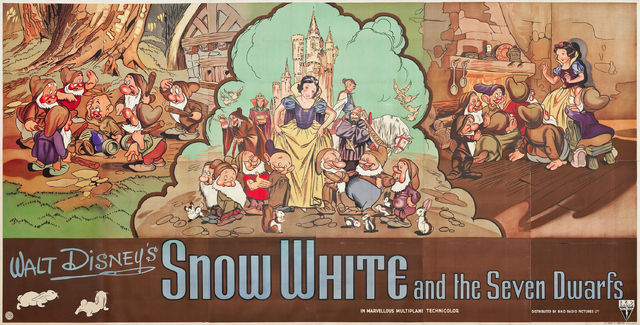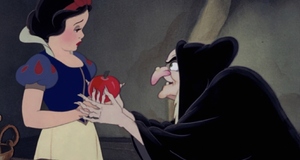The Feminine Threat: Reconsidering the Damsel in Distress in Early Disney Films
By
2017, Vol. 9 No. 11 | pg. 1/1
KEYWORDS:
“Disney perpetuated a male myth through his fairy-tale films,” argues Jack Zipes (1995, p. 37). He writes that Walt Disney framed “women’s lives through a male discourse” in his films (p. 36), and that he reinforced “nineteenth-century patriarchal notions” and “benevolent attitudes toward women” (p. 37). This paper looks at Walt Disney Pictures films released in the 30-year period between 1937 and 1967, from the company’s first feature-length film, Snow White and the Seven Dwarfs, to The Jungle Book, the last film Walt Disney himself worked on before his death. By reconsidering female characters--not as damsels in distress, but as successful manipulators--this paper traces the portrayal of women in relation to men: specifically, how by framing femininity in opposition to masculinity, female characters were portrayed as potential threats to the Disney men. Edward Schiappa (2008) argues that there are three “gender lenses” embedded in our culture, and explains that they work to reproduce male power. Gender polarization means that the two sexes are identified as opposites, and that they can be defined by oppositional attributes: if one sex is aggressive, the other must be gentle; if one is dominant, the other must be submissive; if one is strong, the other must be weak. Biological essentialism means that these differences between the sexes are naturally coded as innate qualities, rather than products of circumstance or upbringing. Lastly, androcentrism defines masculinity as the norm, and anything else in comparison to the male (man and wo-man): there is male and the opposite of male; there is male and non-male. Schiappa argues that all three of these ideological beliefs “are widely shared in U.S. culture and... perpetuate sexist attitudes” (p. 15). Disney’s women are not merely damsels in distress; rather, they use their positions of weakness to exploit empathy and affection--and the men keep falling for it. In Disney’s first feature film, Snow White and the Seven Dwarfs (1937), Snow White uses her female influence to domesticate the dwarves. Upon reaching their cottage, she immediately takes note of how dirty it is. Her natural instinct is to clean the cottage for the owners, in hope that they will let her stay in return. However, the dwarves’ reactions are not those of gratitude. In shock and disbelief, one even exclaims: “Hey, someone stole our dishes!” The assumption behind this conflict is that women are tidy and organized, whereas men are messy and filthy, but the implication is also that women corrupt and disrupt the spaces of men. Snow White’s femininity, coded as the tidied-up cottage, directly threatens the dwarves’ masculinity, coded as the messy cottage. This binary (the tidy vs. the dirty) will find itself repeated throughout the Disney canon.Snow White’s influence goes even further when she orders the dwarves to wash their hands. Although she was just in a position of weakness--literally begging the dwarves to let her stay--their empathy and worshipful affection for her femininity has quickly shifted her into a position of power and made her into a figure of authority, to the point at which she even infantilizes them. Her new position allows her to demand of the dwarves: “Let me see your hands.” Her authority even allows her to pose ultimatums: “March straight outside to wash, or you’ll not get a bite to eat.” Like their cottage, the dwarves’ filthy hands need to be cleansed; their masculinity needs to be feminized. Of the seven dwarves, only Grumpy realizes the potential threat Snow White poses to their masculinity, and he tries to resist her self-claimed authority, warning the others: “You give them an inch, and they’ll walk all over you.” Grumpy is the only one to recognize that Snow White’s domesticity threatens the dwarves’ freedom, but while he rejects her femininity for as long as he can (a few hours), he eventually (by morning) succumbs to her powers as well. Snow White stands in opposition to Zipes’ claim that “the young women are helpless ornaments in need of protection” (1995, p. 37). On the contrary, Walt Disney seems to have thought the opposite: the Disney princesses possess enormous influence and power, using their beauty and femininity to wrap the Disney men around their fingers. Even in Bambi (1942) the Owl explains the dangers of running into a “pretty face.” Similar sentiments are expressed in Lady and the Tramp (1955). Boris, the dog pound philosopher, argues that “even Tramp has his Achille’s heel.” The dogs explain that “the dames” are his “weaknesses,” before listing his many previous partners, none of which he settled for. They then go on to explain that someday he will meet “someone different,” but that “under the spell of true love, the poor chump grows careless,” implying he will get caught by the dog catcher. In this instance, Tramp is not merely faced with the threat of lost masculinity, but with imprisonment and possibly death. Femininity and domesticity in this instance equal weakness and carelessness, and they have never been more dangerous. Schiappa (2008) lists typical attributes identified in the Bem Sex Role Inventory, as well as the Conformity to Masculine Norms Inventory and the Conformity to Feminine Norms Inventory. Some masculine attributes are: assertiveness, dominance, aggression, ambition, self-reliance, and independence. The feminine traits he lists are polar opposites to the masculine: yielding, gullible, gentle, shy, modest, and domestic (p. 17). These traits are clearly demonstrated in the characters in Lady and the Tramp, as well as in most Disney films. This polarization causes great conflict between the masculine and the feminine. As Lady and Tramp look out from the hill, Lady notices the “nice homes, yards, and fences,” reestablishing her domestic identity. Tramp looks beyond the city, and speaks enthusiastically about the “adventure and excitement” that lies outside the fences. To him, domesticity is a trap that threatens his freedom and independence, things he must give up if he wishes to be with Lady. As Tramp himself says, “that’s what comes with tying yourself down to one family.” And when he eventually does, there is a sense of sacrifice and martyrdom, having sacrificed, not only his freedom and independence, but also his masculinity. This same sacrifice is repeated in the Disney canon most notably with Thomas O’Malley in The Aristocats (1970), who sacrifices his life on the streets to become part of Duchess’ domestic family (his newfound domesticity perfectly captured by him wearing a bowtie at the end of the film--a symbolic collar, signaling both ownership and captivity). In Mary Poppins (1964) the titular character quickly becomes a threat to the authority of the father of the Banks family, George Banks, as she questions his place in the household: “You are the father of Jane and Michael Banks, are you not?” George is thrown off by her assertive tone. The question works on multiple planes: both as absurd comic relief, and to point out his neglect of his children and overall shortcomings as a patriarch. Chris Cuomo writes that, “given the changing roles of women, men must reorient themselves to what is rightfully theirs in order to maintain control” (1995, p. 216). Again, femininity threatens the role of the patriarch. Mary Poppins challenges the father of the Banks family as the main authority with his children, but while she exhibits traits typically associated with masculinity, it is not these that threaten him. Rather, he worries that she will “undermine the discipline” in the household through “worthless frivolity” like song and “tea parties on the ceiling,” activities he believes are feminine. Instead, he wishes his children would “learn the seriousness of life” by doing real, masculine, work (such as working at the bank). The mother of the Banks family, Winifred Banks, is portrayed as an “upper-class British suffragette mother.” However, Cuomo observes that her “activism warrants hardly a comment” from the other characters, and describes Winifred’s portrayal as “somewhat silly and ineffectual” (1995, p. 215): Winifred’s feminism is not simply ignored, but actively ridiculed. One could even argue that her portrayal as a feminist is highly contradictory, as she seems to be under tight control of her husband. But when looking closer, it is possible to detect a strong resistance in Winifred, and a fear in George of his wife’s activism: he understands the threat she poses to his authority, and his only way to control it is to dominate her and to ridicule her activities. The audience knows from the outset that George disapproves of Winifred’s activism, which Cuomo also points to. As George is about to come home, Winifred takes off her rally sash, and says to the maids: “Put these things away. You know how The Cause infuriates Mr. Banks.” She is clearly aware of her husband’s attitude toward “The Cause”; as such, her activism becomes an act of defiance toward her husband: she does not hide the sash in fear of George’s reaction; she hides it to keep him from realizing the extent of her threat--feminine and otherwise. Cuomo even goes as far as to suggest that Winifred might be a “closet terrorist” (1995, p. 215). Her resistance becomes even clearer when she tells George: “I’d love to stay, but I have to dress for my rally in Hampstead.” George insists she stay and she immediately says, “Oh yes, George, of course,” but walks away to sit down on a chair on the opposite end of the room. As George lectures Poppins on his beliefs, Winifred interrupts him to side with Poppins, asking, “George, are you certain you know what you are doing?” Winifred resists George’s authority by faking her own submission, when in reality, Poppins and Winifred manipulate him by putting ideas in his head. And, when George questions if it really was his idea, Winifred is quick to respond: “It certainly sounded that way, dear.” At the end of the film, Winifred uses her “Votes for Women” sash as a tail on the family’s kite: this could suggest feminism was a distraction she no longer needs to preoccupy herself with as the family is reunited and she again finds a place in the domestic home; however, it is more likely that she sees this as a chance to further her own political agenda, as she broadcasts her ideological beliefs from the sky. Ultimately, she turns the reunited family’s first activity into a political act, knowingly tricking her gullible husband into participating in the fight for her feminine cause. While Winifred’s portrayal as a feminist activist is ultimately neglected, she poses a great threat to George’s authority. But, as “mother is preoccupied, father is absent,” and “this British family is on the verge of collapse” (Cuomo, 1995, p. 214), Mary Poppins’ intervention comes through a revived threat to the patriarchy: the fusion of feminine with masculine. However, the solution is not found in repolarization, but in depolarization, as the father “reorients” himself, eventually embracing femininity as well as masculinity, restoring order, and reuniting the family. In The Jungle Book (1967) Colonel Hathi is also challenged by a female: his wife--also conveniently named Winifred. As Bagheera pleads for the Colonel and his elephant patrol to help him search for Mowgli, the stubborn elephant refuses. Winifred intervenes, with a serious threat: “You help find him, or I’m taking over command.” The Colonel is taken aback: “What? A female leading my heard? Utterly preposterous!” However, he quickly changes his mind under the influence of his son’s emotional pleading (and perhaps to save face). Winifred’s assertive threats are ineffective compared to her son’s feminine emotion, again establishing emotional femininity as superiorly powerful to assertive masculinity. Mary Poppins and the two Winifreds are not only testaments to changing attitudes in Disney women, but they all represent different ends of the spectrum: they are all taking charge, but through different means. Hathi’s Winifred finds power in her masculine traits, while Winifred Banks finds strength in her femininity; Mary Poppins finds strength in both. Women possessing masculine traits pose the greatest threat to men: the more assertive and aggressive women become, the weaker men look in comparison, and they must “make up” for this shift by proving themselves more powerful and masculine in defense and opposition to the women. But when femininity is disguised as weakness, men lower their guards, and it passes undetected as a threat. Ultimately, where masculinity fails, femininity fools. In the final scene of The Jungle Book, Mowgli becomes entranced by the song of a girl from the man-village. Baloo tells him to “forget about those, they ain’t nothing but trouble.” But Mowgli decides to have “a closer look.” Elizabeth Bell writes about the “Femmes Fatales”--“the beautiful witches, queens, and stepmothers”--of Disney films. She writes that the Disney seductress first turns her neck, and “having first revealed enormously wide eyes, she slowly veils them with soft lids” (1995, p. 115). This trope applies to the young girl in this scene as well, after she deliberately drops her water pot to make Mowgli follow her to the man-village. The girl sings, “I will have a handsome husband... I’ll be cooking in the home.” She knows exactly what she wants, and exactly how to get it. Baloo sees through her game, pleading to Mowgli: “Come back, come back!” But Mowgli has been enthralled by her femininity, and leaves his innate masculinity--as he is tricked into carrying the girl’s water pot, a daughter’s job--and the jungle behind him in order to be domesticated. Much like Tramp and O’Malley, he sacrifices his freedom and independence for femininity. The feminine threat is subtly, and sometimes not so subtly, portrayed through binaries in many of Disney’s films: masculinity opposes femininity; independence opposes family; freedom opposes domesticity. In either case, Disney’s women have been using their femininity to enforce feminine values on the men around them--whether for love, for family, or for protection--ever since Snow White first entered the dwarves’ cottage. And where assertiveness and masculinity fails, Disney’s women find power in emotion and femininity. Although it presents them with a limited repertoire--from beauty, dance, and song, to domestic housework and submission--they have found different ways to use these powers, whether they wield their beauty and song to entice the men with affection, or fake submission to make them believe they are in charge. The men in Disney films often fear losing their freedom, self-reliance, and dominance. More so, they fear being dominated by women who “wrap them around their fingers.” Because of this, they often reject all things feminine, finding comfort in proving their own masculinity. And although the women eventually win, it is not without effort and suffering. Compared to the earlier films, the women have become more assertive in the ways they exploit their femininity: Snow White uses good looks and domestic house work, learned from her previous enslavement, to make the dwarves let her stay; in The Jungle Book, all it takes is a song and a bat of an eyelash to domesticate Mowgli. Disney’s women are not merely damsels in distress; rather, they use their positions of weakness to exploit empathy and affection--and the men keep falling for it. Whether they want to or not, the men eventually come to terms with the shift of power--though not without resistance. And when the women get married into lives of inferred domesticity and submission, though they may very well live happily ever after--don’t be mistaken about who runs the show. The real victims in the Disney fairy-tales are not damsels in distress, but the men who follow their orders. ReferencesBell, E. (1995). Somatexts at the Disney shop: Constructing the pentimentos of women’s animated bodies. In E. Bell, L. Haas & L. Sells (Eds.), From mouse to mermaid: The politics of film, gender, and culture (pp. 107-124). Bloomington, IN: Indiana University Press. Cuomo, C. (1995). Spinsters in sensible shoes: Mary Poppins and Bedknobs and Broomsticks. In E. Bell, L. Haas & L. Sells (Eds.), From mouse to mermaid: The politics of film, gender, and culture (pp. 212-223). Bloomington, IN: Indiana University Press. Disney, W. (Producer), Geronimi, C. (Director), Jackson, W. (Director), Luske, H. (Director). (1955). Lady and the Tramp [Motion Picture]. United States: Walt Disney Productions. Disney, W. (Producer), Hand, D. (Supervising Director). (1937). Snow White and the Seven Dwarfs [Motion Picture]. United States: Walt Disney Productions. Disney, W. (Producer), Hand, D. (Supervising Director). (1942). Bambi [Motion Picture]. United States: Walt Disney Productions. Disney, W. (Producer), Reitherman, W. (Director). (1967). The Jungle Book [Motion Picture]. United States: Walt Disney Productions. Disney, W. (Producer), Walsh, B. (Producer), Stevenson, R. (Director). (1964). Mary Poppins [Motion Picture]. United States: Walt Disney Productions. Hibler, W. (Producer), Reitherman, W. (Director). (1970). The Aristocats [Motion Picture]. United States: Walt Disney Productions. Schiappa, E. (2008). Beyond representational correctness: Rethinking criticism of popular media. Albany, NY: State University of New York Press. Zipes, J. (1995). Breaking the Disney spell. In E. Bell, L. Haas & L. Sells (Eds.), From mouse to mermaid: The politics of film, gender, and culture (pp. 21-42). Bloomington, IN: Indiana University Press. Suggested Reading from Inquiries Journal
Inquiries Journal provides undergraduate and graduate students around the world a platform for the wide dissemination of academic work over a range of core disciplines. Representing the work of students from hundreds of institutions around the globe, Inquiries Journal's large database of academic articles is completely free. Learn more | Blog | Submit Latest in Film & Media |



















